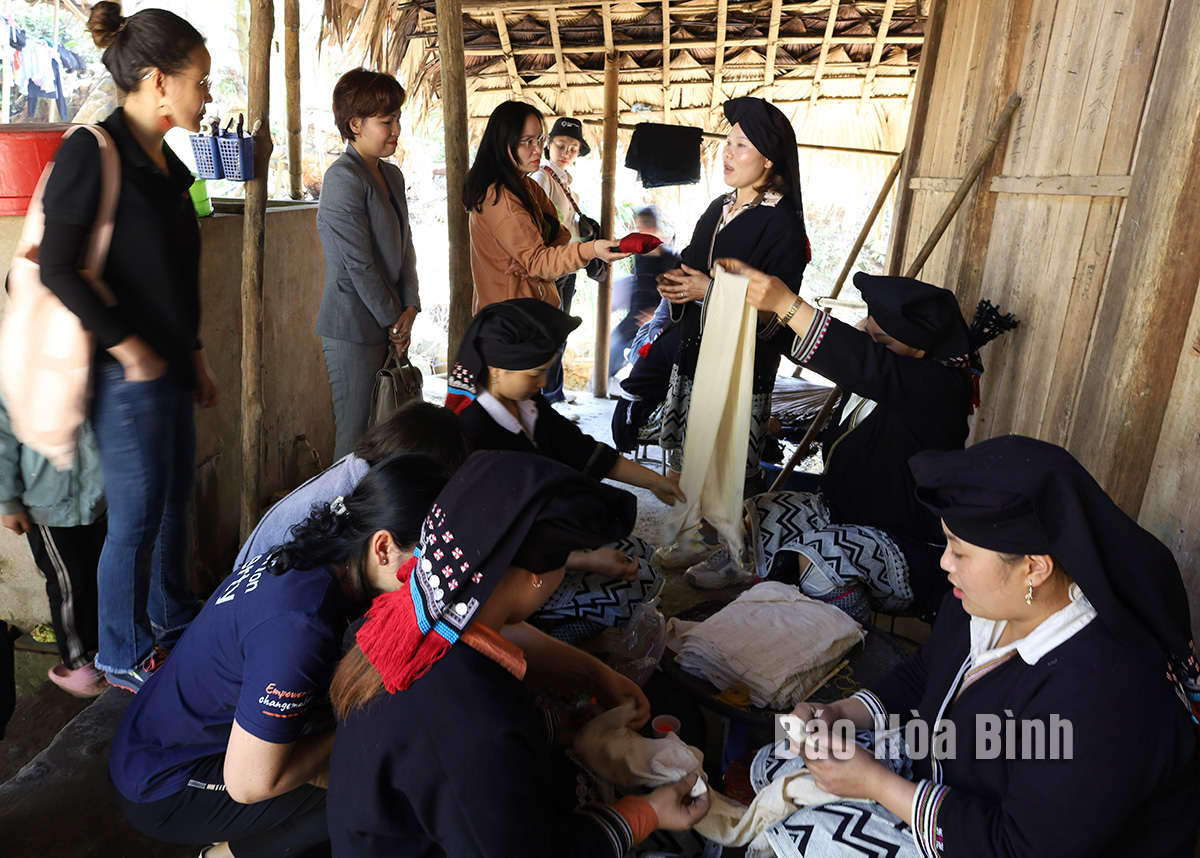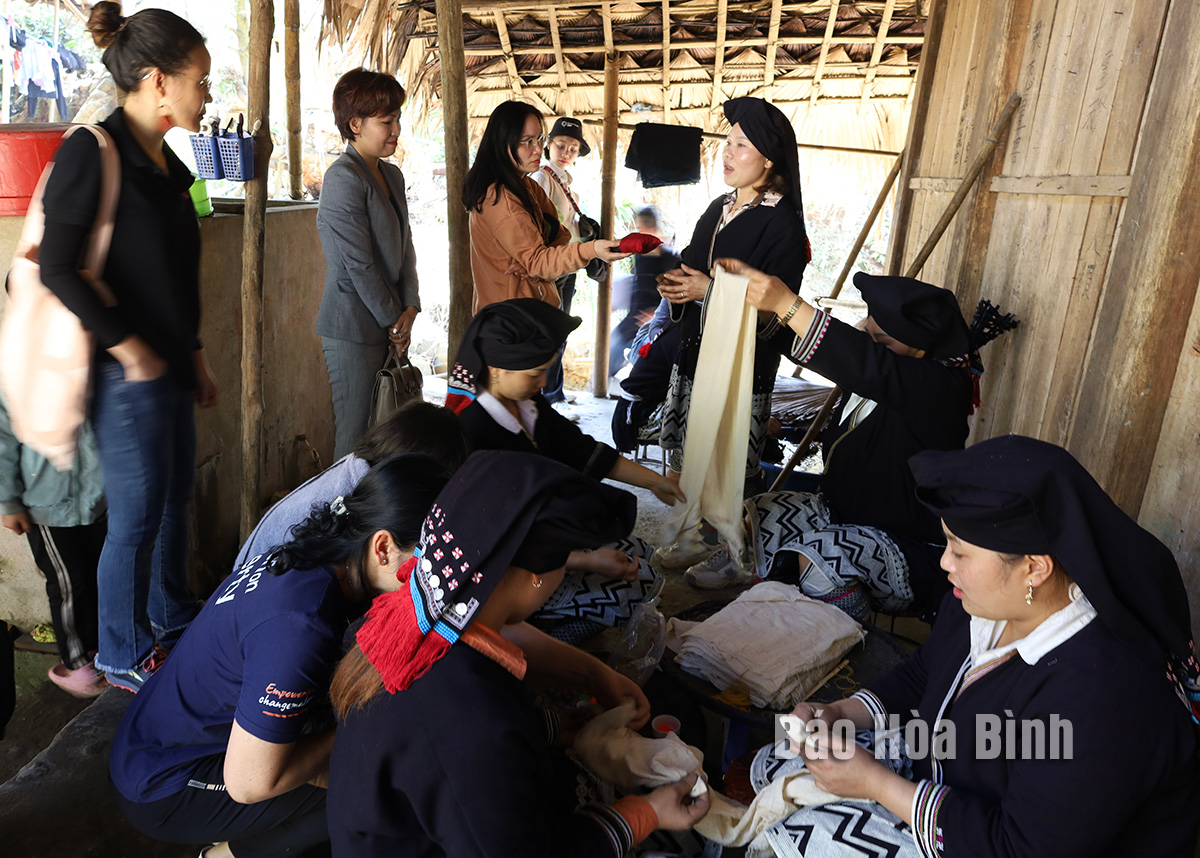
With the diverse cultural identities of the Muong, Tay, Dao, and Thai ethnic groups and endowed with natural beauty, the mountainous district of Da Bac has been gradually developing tourism in association with preserving and promoting traditional cultural values.
In addition to community-based tourism attractions, resorts and
eco-tourism areas have been invested and put into operation in the district,
offering tourist products. Party committees and local authorities pay attention
to annual festival activities such as the Dao people’s New Year festival in Cao
Son commune, the Thac Bo temple festival in Vay Nua commune, the Muong bridge
festival in Muong Chieng commune and many other small festivals to increase
tourism attraction.
Photo: Tourists experience dyeing to create brocade in Sung hamlet, Cao Son
commune, Da Bac district.
According to Nguyen Van Toan, head of the Culture and Information Department of
Da Bac district, local scenic spots are being exploited to serve tourism
development. For example, Thac Bo temple in Vay Nua commune, the place to
worship Dinh Thi Van - a woman who helped people and soldiers transport food
through Thac Bo to Muong Le (in neighbouring Son La province). Visitors to the
temple usually make pilgrimages, pray for fortune and good luck, go
sightseeing, and enjoy the fresh air there.
Meanwhile, when visiting the nearby Coconut island, visitors can
walk around the island, visit orchards, enjoy fruits, sail surrounding the
island, enjoy local specialties and stay overnight in lovely stilt houses.
A scenic spot that is popular with many tourists, especially foreigners, is the
1,580-ha Pu Canh Nature Reserve spaaning the communes of Doan Ket, Yen Hoa,
Dong Ruong and Dong Chum. The reserve boasts rich flora and fauna ecosystems,
waterfalls, streams and primary forests. The Tay and Muong ethnic people live
at the foot of the Pu Canh mountain with various unique cultural features from
costumes, scripts, and cuisine plus gentle and friendly native people, which
are favourable conditions to develop eco-tourism, and experiential and
adventure tourism.
Since 2017, households in villages along Hoa Binh lake have developed
community-based tourism, for example, Sac Luyen, Sanh Thuan, Huu Thao, and Ha
Khanh homestays in Ke hamlet, Hien Luong commune.
Using the homestay service, tourists can experience life with the Muong ethnic
people, and take physical activities such as cycling, swimming, kayaking, and
go fishing.
Several popular resorts in the districts are Mai Da Lodge in Doan Ket hamlet -
Tien Phong commune; Xoan Retreat Da Bac in Mo hamlet, Da Bac Ecolodge in Mai
hamlet, Hien Luong commune; and Ho Tam homestay in Cao Son commune.
In addition, visitors to Da Bac can explore beautiful caves and waterfalls,
such as Lo Lan cave in Hien Luong commune, Ho Vang cave in Nanh Nghe commune,
Sung cave in Cao Son commune, Bong waterfall in Tan Minh commune.
Through communications and promotion programmes by the locality, project
investors and especially the Da Bac Community Tourism joint Stock Company,
local tourism is witnessing significant development. Currently, there are
tourism programmes for tourist groups including a three-day tour to explore the
customs and nature of the Muong ethnic group in Da Bac and Tan Lac; a two-day
tour to explore the customs and nature of the Muong ethnic area in Ke and Da
Bia hamlets; the two-day tour named "Sacred Forest Footprints” to explore the
traditional culture and pristine nature of the Dao Tien people in Sung
hamlet.
In the first 9 months of 2024, Hoa Binh province continues to implement the expanded tourism development cooperation program plan of 8 Northwest provinces with Ho Chi Minh City; deploying digital transformation content in tourism and developing a smart tourism province. Hoa Binh province received about 3.6 million views, an increase of 7.9% over the same period. In which, international visitors are about 380 visitors, domestic visitors are estimated at 3 million 220 visitors.
Spanning thousands of hectares and winding gracefully along mountain slopes, hillsides, and riverbanks, the terraced rice fields of Lac Son District present a stunning and captivating beauty. This region, renowned for its remarkable terraced landscapes, is also the centre of Hoa Binh Culture known for numerous archaeological sites.
The life of Mong people in Hang Kia and Pa Co communes of Mai Chau district has improved much thanks to tourism development.
The man-made Hoa Binh Lake, with a water surface area of approximately 9,000 hectares and a capacity of 9.45 billion cubic meters, stretches over 200 kilometers from Hoa Binh to Son La provinces. With the goal of developing into a national tourism area, the Hoa Binh Lake tourism area is expected to not only become the largest tourism centre in the province but also one of the 12 key tourist destinations in the northern midland and mountainous region of Vietnam.
Da Bia hamlet, now Duc Phong, in Tien Phong commune, Da Bac district, was once almost isolated from the outside as the only way to the hamlet was to get a boat ride across the Hoa Binh reservoir. However, as its tourism potential has been unleashed, the hamlet has established itself as one of the most attractive destinations on the tourism map. It has even received the ASEAN Community-Based Tourism Awards in 2019.
In the first 9 months of 2024, Mai Chau district, Hoa Binh province welcomed over 684 thousand visitors to visit and relax. In which, over 516 thousand domestic visitors and more than 168 thousand international visitors. Total revenue from tourism is estimated at over 821 billion VND.



